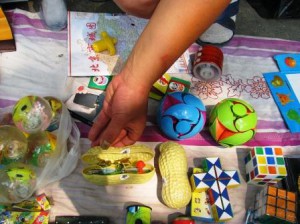![]() It has been almost 10 days since the publication of Increased Food and Ecosystem Security via Perennial Grains in the Policy Forum of the journal Science. ((Glover, J., Reganold, J., Bell, L., Borevitz, J., Brummer, E., Buckler, E., Cox, C., Cox, T., Crews, T., Culman, S., DeHaan, L., Eriksson, D., Gill, B., Holland, J., Hu, F., Hulke, B., Ibrahim, A., Jackson, W., Jones, S., Murray, S., Paterson, A., Ploschuk, E., Sacks, E., Snapp, S., Tao, D., Van Tassel, D., Wade, L., Wyse, D., & Xu, Y. (2010). Increased Food and Ecosystem Security via Perennial Grains Science, 328 (5986), 1638-1639 DOI: 10.1126/science.1188761)) Not long in the 10,000 year history of agriculture, agreed, but long enough to have had a bit more impact, which it deserves for two reasons. First, there’s the subject itself: perennial grains. Then, there’s where it appeared; Science is pretty mainstream on most things, and its willingness to publish 29 authors from 21 institutions must help to bring perennial grains in from the cold.
It has been almost 10 days since the publication of Increased Food and Ecosystem Security via Perennial Grains in the Policy Forum of the journal Science. ((Glover, J., Reganold, J., Bell, L., Borevitz, J., Brummer, E., Buckler, E., Cox, C., Cox, T., Crews, T., Culman, S., DeHaan, L., Eriksson, D., Gill, B., Holland, J., Hu, F., Hulke, B., Ibrahim, A., Jackson, W., Jones, S., Murray, S., Paterson, A., Ploschuk, E., Sacks, E., Snapp, S., Tao, D., Van Tassel, D., Wade, L., Wyse, D., & Xu, Y. (2010). Increased Food and Ecosystem Security via Perennial Grains Science, 328 (5986), 1638-1639 DOI: 10.1126/science.1188761)) Not long in the 10,000 year history of agriculture, agreed, but long enough to have had a bit more impact, which it deserves for two reasons. First, there’s the subject itself: perennial grains. Then, there’s where it appeared; Science is pretty mainstream on most things, and its willingness to publish 29 authors from 21 institutions must help to bring perennial grains in from the cold.
As ever, the article is behind a paywall, so a summary is in order. Jerry Glover, of the Land institute in Salinas, Kansas, and his co-authors make several points. Grain yields from major crops have doubled since the 1950s, but 1 in 7 people are malnourished. Populations continue to grow, and biofuels are competing with food production. The best croplands are not at risk of soil erosion or degradation, but those lands are only 12.6% of total land area. More than half the world’s population depends instead on marginal lands, which are capable of growing crops but which are at risk of degradation under annual crops. Global food security depends on annual production of cereals, legumes and oilseeds, but for a variety of reasons the production of these staples is unsustainable and fragile. Against this background, as the authors say:
Development of perennial versions of important grain crops could expand options.
They go on to list the benefits of perennial crops, which I won’t repeat here, and some of the past history of this exciting research area. One of the key arguments against perennial crops is that plants make a trade-off between storing resources to overwinter vegetatively and putting those resources into seeds that can survive adverse conditions. In other words, you can have deep roots etc. or big seeds, but not both. But even if true, perennial grains may still be a good idea, for two reasons.
First, high yield is not the only factor governing the use of specific crops. Wheat, for example, yields less than maize, but is grown on a larger area than maize because it will produce some yield under conditions where most maize will produce none.
[L]ower yield perennial crops could be options where higher yield annuals cannot reliably achieve full yields. In semiarid regions of sub-Saharan Africa, annual crops often use less than 30% of rainfall due to high rates of water draining below root zones, evaporation and runoff … Perennial crops can reduce … water losses and be grown on highly erodable sites. For example perennial types of pigeon peas, important food crops and sources of biologically fixed nitrogen, are grown on steep slopes in regions of Malawi, China, and India.
The second reason perennial crops may be a good idea even though yields remain lower at present is that by virtue of their deeper roots and longer-lived leaf canopy, they can convert more sunlight into biomass than even the most advanced, most pampered annual crops. Miscanthus (a grass heavily touted for biofuel production) for example, with no additional fertilizer, produces almost 60% more aboveground biomass than heavily-fertilized maize.
Glover and his co-authors point out that plant breeders need to combine many desirable traits in perennial grains, and that new technologies like genome screening and marker-assisted selection can speed the process. They also point out that this requires greater investment, calling for new and expanded breeding programmes, expanded research, better global coordination, agreed prioritiy-setting and capacity development and training. ((Sound familiar?)) They also identify the many ways in which perennial crops could contribute to what they call “domestic and international challenges,” pointing out that several US agencies ought to have an interest in promoting R&D into perennial grains.
And that, perhaps, is where the article’s real importance lies, and why I am a little surprised that it has not (yet?) generated more discussion. With governments increasingly talking about food security in a much broader context than mere calories and proteins, and given Science’s clout as an outlet for important ideas, one can but hope that somewhere serious-minded people are considering shifting just a tiny bit of the agricultural research budget into obviously attractive alternatives to seeds and feeds.

